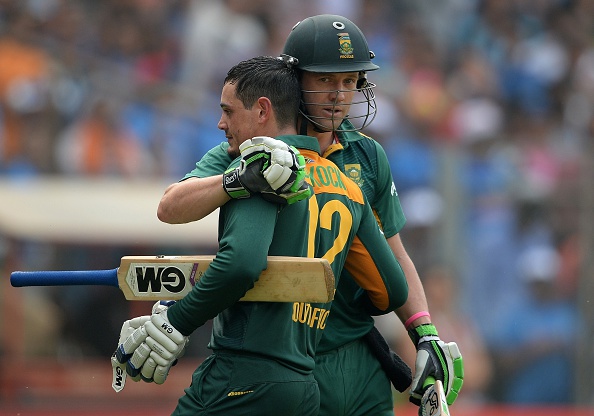The Proteas and Quinton de Kock in particular would benefit from Faf du Plessis and AB de Villiers’ inclusion at the T20 World Cup, writes JON CARDINELLI.
South African cricket is starting to get answers if not results. The recent T20I series against England revealed that the Proteas have a lead-from-the-front skipper in Quinton de Kock and another world-class opening batsman in Temba Bavuma.
The attack struggled to perform with any great consistency. Dale Steyn showed an intent to experiment with the flight and pace of his deliveries, though, and could be a major asset later this season.
The Proteas will play the first of a three-game series against Australia this Friday. The big news is that Du Plessis and Kagiso Rabada have returned to the squad after being rested for the white-ball matches against England.
ALSO READ: Du Plessis permanently hands over captaincy reins
Du Plessis, who recently stepped down as skipper in all three formats, looks set to travel to the T20 World Cup as a frontline batsman and sounding board for the relatively inexperienced De Kock. It will be interesting to see how Du Plessis dovetails with the new leadership regime in the next three games.
Coach Mark Boucher recently hinted that De Villiers – one of the most gifted players of his generation – could feature for the Proteas at the T20 World Cup in Australia later this year. While the former South African skipper has not played international cricket for more than two years, and while it’s not yet known when exactly he will return, Boucher clearly believes that De Villiers has what it takes to shape South Africa’s destiny at the tournament.
Batting has been a problem at ICC tournaments. De Villiers was one of the top run-scorers at the 2015 World Cup and Du Plessis was the best of a bad bunch at the 2019 showpiece. The majority of the batsmen in the top and middle order, however, failed to register totals of consequence and put the rest of the team under pressure.
Some may argue that this new-look team needs to forge its own path. De Villiers, Du Plessis and Steyn have been part of several failed ICC campaigns in the past. Perhaps it’s time to start afresh.
On the other hand, the trio do possess a good idea about what to expect having competed in that high-pressure environment on so many occasions. De Kock himself has been at two 50-over World Cups, and the coming 20-over showpiece will be his first as South Africa’s go-to man. Perhaps he could do with some help in the shape of a veteran or three.
ALSO READ: Proteas lose Bavuma for first T20I
De Kock has found some support from Bavuma and Rassie van der Dussen in recent weeks. However, the presence of Du Plessis and De Villiers will certainly ease the pressure on the new skipper – who led the ODI side for the first time on 4 February and won’t have a great deal of experience by the time the T20 World Cup rolls around in October.
How often have we seen young skippers turning to senior members of the team in times of crisis? It’s not uncommon to see the more seasoned players advising the captain when he has to make a big call with regard to a bowling change or field placing.
De Villiers will add X factor to the batting lineup. Du Plessis has the potential to play big, momentum-changing knocks. If both are available in the lead-up to the T20 World Cup, and if both find form, Boucher would do well to pick them in the final squad.
How do you fit De Villiers and Du Plessis into a batting lineup that may already include De Kock, Bavuma, Van der Dussen, David Miller and Jon-Jon Smuts? Some may ask the question and bemoan the calls to include De Villiers and Du Plessis in a new team that’s bent on striking out in a new direction.
I’d prefer to see the question and the debate as something positive. If all of the above are available, the Proteas will finally have some depth and Boucher might have the right sort of selection headache.
After all, it’s better that the Proteas go into that tournament with too many top- and middle-order options than too few.
Photo: Gallo Images







